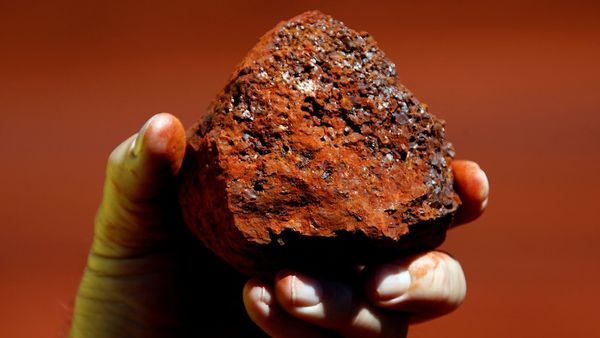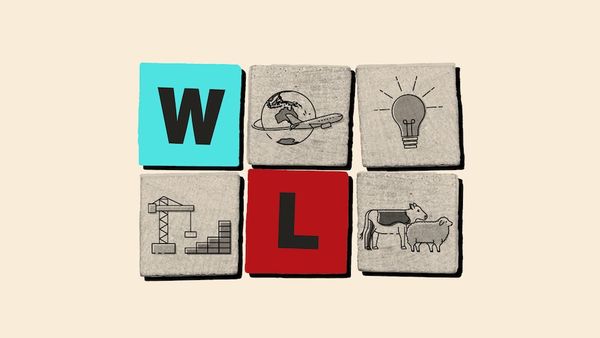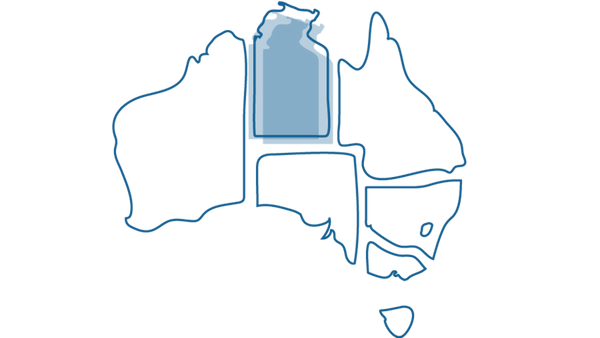Western Australia remains the envy of the nation after recording an eye-watering surplus of $4.2 billion as the rivers of gold continue flowing from the resources industry.
So who is reaping the benefits of this budget, and who is being left behind?
Winner: West Australians
The $4.2 billion surplus for this financial year far exceeds the $1.6 billion that had been predicted, leaving plenty of extra cash to spend on big ticket items like health, housing and cost-of-living relief.
The state's riches have been underpinned by higher-than-expected iron ore royalties, driven largely by continued, strong demand from China — WA's biggest trading partner.
An ever-growing stream of GST revenue from Canberra due to the strong economy and rising inflation has also bolstered the state's bottom line.
The 2023-2024 surplus is projected to be a slightly more modest $3.3 billion, with the iron ore price expected to drop — but they said that last year too.
Neutral: Households
A $715 million cost-of-living package, jointly funded by the state and federal governments, will mean every household in the state gets a $400 power bill credit as a minimum.
Around 350,000, or about one third of households, including pensioners and health care card holders, will receive a total of $826 in support, thanks to an extra federal government subsidy.
Household fees and charges will be kept below the rate of inflation for the fourth year in a row, with the overall cost of a basket of goods rising by 2.4 per cent — lower than the rate of inflation, which is expected to fall to 3.5 per cent in 2023-2024.
Electricity and water charges will rise by 2.5 per cent, public transport fares by 2 per cent and vehicle licensing charges by 3.9 per cent.
The hardship utilities credit will be boosted by 10 per cent to $640 per household, the seniors' cost of living rebate will be increased in line with inflation and eligible small businesses will receive a $650 electricity credit.
The $400 power bill credit that will be received by two thirds of households is equal to the credit dished out last year, but less than the $600 provided the year before.
But while it all helps, households are still worse off overall this year as they grapple with the sky-high rate of inflation.
Winner: Health
The McGowan government has pledged $2.7 billion in spending on health and mental health facilities, bringing the total spend in the sector to $10 billion since 2021.
This includes $841 million on hospital services, $78 million for COVID prevention and $75 million on addressing emergency department pressures.
There will be $28.5 million allocated to attract and retain health care workers, with HECS-HELP loans up to $12,000 being paid for nurses and midwives starting jobs in regional WA.
The new Women and Babies Hospital being built in the Fiona Stanley precinct will be given $544 million, while the Bentley Health Service SurgiCentre will get $150 million.
The budget will see $420 million spent on mental health, with $219 million set aside for stage one of the expansion of Graylands Hospital.
There will be $82.6 million spent on mental health hospital services, and $35.5 million to improve mental health in children and adolescents.
Other spending will devote $99.4 million to the electronic medical records roll out, $58 million for IT improvements and $24.4 million for the WACHS mental health emergency telehealth service.
Neutral: Environment
There's little in the State Budget that will set the pulses of environmentalists racing, with relatively meagre funding for ecological initiatives.
Key among them will be $36 million for the next Forest Management Plan from 2024-2033, through which the government has vowed to end all native timber logging in the South West.
Feral cats should also be on notice, with $7.6 million for a strategy to help tackle the pests, which continue to cause devastation among WA's native wildlife.
On top of these, the budget also sets aside about $50 million for the state's newest marine park in the Kimberley's Buccaneer Archipelago.
The money will go towards compensating fishermen whose grounds have been affected by no-take zones, as well as enforcement, education, research and monitoring activities.
Beyond these bigger ticket items, there's also $7 million for the Southern Rangelands Revitalisation Project Expansion, $5 million for water "smart" farms using desalination techniques in the Great Southern and Wheatbelt, and $3.7 million to develop climate "resilience" in Aboriginal communities.
Winner: Housing
A total of $750 million has been set aside to boost housing supply and address homelessness, spearheaded by a $511 million commitment to build 700 new social homes - although there's no timeline for completion.
The commitment includes money to fix up ageing social housing stock to prevent homes from sitting empty, as well as 100 supported landlord homes for those experiencing homelessness in regional WA.
It increases the total spend on social housing and homelessness services to $2.6 billion, delivering an additional 4,000 social housing homes, with 1,200 already delivered.
An Office of Homelessnes will also be established to better co-ordinate the state's social housing stock in an effort to get a roof over the heads of society's most vulnerable.
While it might take a long time to get these houses built, the move has been welcomed with open arms by homelessness support services.
Winner: Construction
Almost $48 million has been set aside to boost the state's building and construction workforce, including $34.2 million to encourage WA businesses to take on local workers and apprentices.
Grants paid to businesses for third and fourth-year apprenticeships will be increased from $10,000 to $12,000, while around 1,900 apprentices and trainees will get a $2,000 completion payment to encourage them to finish off their training.
There's also $11 million in the budget to attract skilled migrant workers with visa subsidies and a temporary relaxation of the migration criteria.
Then there's $33 million to extend off-the-plan stamp duty concessions to encourage more multistorey developments, as the state government continues its battle with local governments to boost density in the suburbs.
While these are all good initiatives, the state's construction sector remains overcooked and constrained by severe labour and supply shortages, which will continue to hamper the construction of new projects.
Loser: Renters
The situation is dire for renters who are grappling with a vacancy rate of just 0.6 per cent.
Research from Anglicare last month found there were none of the state's rentals were affordable for people on Commonwealth payments and even those on a minimum wage are being priced out of the market.
There's only so much the government can do to address the labour shortage but there are some levers it could have pulled to make things easier for renters, such as rent caps, rent assistance, limiting rent increases to once a year and banning no-grounds evictions.
There's little relief for renters in this budget, who will continue to face price hikes and stiff competition as long as demand for properties continues to far outstrip supply.
Loser: Public Servants
There's not much in this budget for public servants because the majority of their pay deals were signed under last year's wages offer.
Those that are left behind, including police and nurses, are still being given the same offer.
But with another surplus under his belt and nothing but extra money on the horizon, pressure on the premier to offer a more generous offer is almost certain to continue.
For today, Mark McGowan only said he'll deal with those issues when negotiations start back up next year, "in light of what the CPI is then at that point in time".
The budget expects inflation to have peaked at 5.75 per cent this financial year, before slowly dropping to 3.5 per cent next year, all the way down to 2.5 per cent in 2026-27.
Neutral: DV victims
The government has set aside $52.5 million for family and domestic violence initiatives, inlcuding $18.3 million over the next three years to support contracted services for refuges and safe houses.
There's also $29.7 million for family and domestic violence hubs in Mirrabooka, Kalgoorlie and Broome.
The hubs aim to provide culturally safe services for people from all backgrounds through partnerships with CALD backgrounds and Aboriginal organisations.
But the sector remains chronically underfunded and many who operate on the smell of an oily rag will argue the government could have been more generous in light of another massive surplus.
And the housing crisis continues to exacerbate the problem, with women routinely turned away from refuges who have nowhere to place them.
Loser: At-risk youth
The government's still trying to work its way through more than $100 million of youth detention funding it announced previously.
Work on an on-country facility in the Kimberley has been hampered on a number of fronts including recent floods, highlighting issues with the site that had been initially chosen.
And Minister Bill Johnston has already flagged that repairing the damage caused in Wednesday's riot at Banksia Hill will slow down other improvements that are planned there.
The budget does include an extra $11.7 million to continue the Operation Regional Shield program, which sends extra police into the regions to combat youth crime in particular.
There's also another $55 million to expand the government's efforts to divert children away from the criminal justice system early.
Mental health advocates say far more needs to be done to look after the welfare of children in detention, with a focus on rehabilitation rather than the "tough love" favoured by the premier.
Neutral: Infrastructure
A total of $39 billion has been allocated for infrastructure over the next four years, but the government will have to compete with the private sector to deliver these projects.
There's a massive $11.2 billion investment in regional infrastructure but cost pressures in the construction and labour markets continue to cause blowouts in vital regional road projects, with the price of the state's most expensive road set to increase again.
The Bunbury Outer Ring Road project has been allocated another $100 million, lifting the price tag of the road to $1.35 billion while the Albany Ring Road's budget has been increased by $40 million.
Another $15 million will be added to the budget for the Great Northern Highway (Ord River North) project, while an extra $30 million has been reserved for the duplication of the Bussell Highway.
Communities impacted by Tropical Cyclone Ellie, which wreaked havoc on the state's north, will get $322 million for projects to rebuild shattered roads and infrastructure.
There's also $24.4 million for a recovery team to respond to natural disasters, $127.8 million to transform the State Hockey Centre and $97.9 million for the Perth Concert Hall to provide the West Australian Symphony Orchestra with a permanent home.
Another $32.2 million is being put towards the upgrade of the WACA, and there's also $15 million for new sports facilities across the state.
Neutral: Education
There's a $965 million investment in education and training, including $325 million for primary and secondary schools and $227 million for new and upgraded school infrastructure.
Almost $95 million will be spent on training initiates targeted at Aboriginal people and women to boost the state's teaching workforce.
The big ticket item in the education portfolio is $100 million for upgrades at Rockingham and Safety Bay high schools south of Perth.
An additional $20.4 million will be invested in the redevelopment of Roebourne District High School in the Pilbara in addition to $52 million that had already been committed.
More than $12 million has been set aside to establish a new program to help around 80 students with disabilities at Wanneroo Secondary College in Perth's north.
More than $10 million was set aside to build an early learning facility for Brabham Primary School to accommodate 350 students.
In an effort to address the dire shortage of nurses in the regions, graduates will be able to access HECS-HELP grants of up to $12,000 over three years to encourage them to work in remote and regional areas.
After the sector was decimated during COVID, $13.1 million has been set aside to continue luring international students back to WA.
Credits:
- Illustration: Emma Machan










